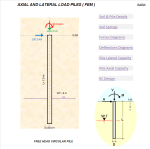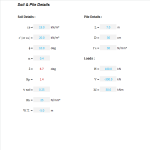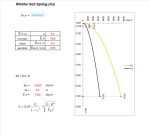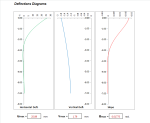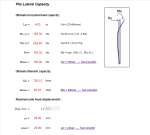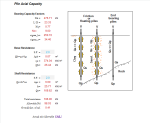AXIAL AND LATERAL LOAD PILES (FEM)
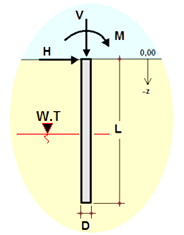
Description
AXIAL AND LATERAL LOAD PILES ( FEM )
-axial load
-moment load
-horizontal load
-deflections diagrams
-forces diagrams
-lateral capacity
-axial capacity
-rc design
(winkler soil model and FEM)
Calculation Reference
Geotechnics
Soil Mechanics
The Finite Element Method
Design of Piles
Reinforced Concrete Design
Axial and lateral load piles are deep foundation elements that are used to transfer loads from the superstructure to the underlying soil or rock. The calculations for axial and lateral load piles involve determining the capacity of the pile to resist the loads and moments acting on the pile.
Axial Load Piles: The calculation for axial load piles involves the following steps:
- Determine the soil properties, such as the soil type, unit weight, angle of internal friction, and cohesion.
- Determine the design load for the pile, which includes the dead load, live load, and any other loads or surcharges that may act on the pile.
- Determine the ultimate capacity of the pile using methods such as static pile load tests, dynamic pile load tests, or analytical methods based on the soil properties and pile geometry.
- Calculate the allowable capacity of the pile by applying a factor of safety to the ultimate capacity, typically ranging from 2.5 to 4.0.
- Determine the required diameter and length of the pile based on the allowable capacity and the design load.
Lateral Load Piles: The calculation for lateral load piles involves the following steps:
- Determine the soil properties, such as the soil type, unit weight, angle of internal friction, and cohesion.
- Determine the design lateral load for the pile, which includes the wind load, earthquake load, or any other lateral loads that may act on the pile.
- Determine the moment of the pile using the design lateral load and the distance between the pile and the point of rotation.
- Determine the ultimate capacity of the pile to resist lateral loads using methods such as lateral pile load tests, dynamic pile load tests, or analytical methods based on the soil properties and pile geometry.
- Calculate the allowable capacity of the pile by applying a factor of safety to the ultimate capacity, typically ranging from 2.5 to 4.0.
- Determine the required diameter and length of the pile based on the allowable capacity and the design lateral load.
Overall, the calculations for axial and lateral load piles require a thorough understanding of the soil properties, pile geometry, and loading conditions, and should be performed by qualified and experienced engineers using appropriate methods and techniques.
Calculation Preview
Full download access to any calculation is available to users with a paid or awarded subscription (XLC Pro).
Subscriptions are free to contributors to the site, alternatively they can be purchased.
Click here for information on subscriptions.

